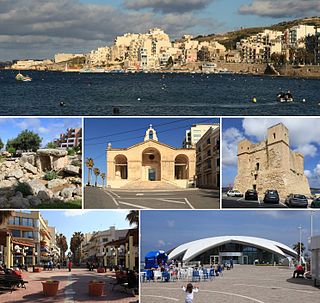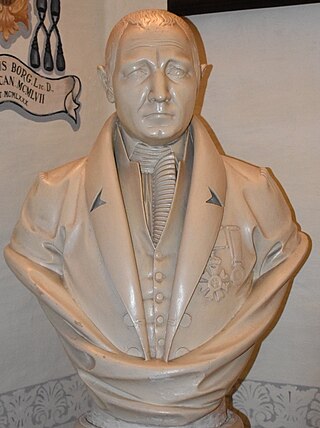Works

- towers at Qawra Point,
- John F. Kennedy memorial at Qawra
- new town at Santa Lucija
- Carmelite Church, Balluta
- Villa Spiteri at Ta' Xbiex
Joseph M. Spiteri or Joe Spiteri (1934-2013) was a Maltese architect.
Spiteri graduated from the University of Malta in 1958. From 1956 to 1975, he worked as an architect in the Public Works Department, and later as Senior Architect with MaltConsult. In 1979 he joined the University of Malta's Department of Architecture and Civil Engineering, where he taught architectural design until 2002. [1]
According to Conrad Thake, Spiteri "was one of Malta’s leading postwar architects who was instrumental in promoting modernism in an era when modern architecture was still viewed with suspicion if not outright derision." He "was a strong believer in sketching and drawing, as a means of communicating ideas, and a skilled water colourist", driven by a "passionate concern with the built environment". [1]
Perit Joe Spiteri was one of Malta’s leading postwar architects who was instrumental in promoting modernism in an era when modern architecture was still viewed with suspicion if not outright derision. His main architectural works ranging from his Corbusian-style house on pilotis at Ta' Xbiex, the spiritually-uplifting Balluta parish church, the dignified John F. Kennedy memorial at Qawra, and the urban planning of the Santa Lucija housing estate are all testimony to his wide-ranging talent in architectural design and urban planning. [1]


Saint Julian's is a town in the Central Region of Malta. As of 2020, its registered number of inhabitants stands at 13,792. It is situated along the coast, north of the country's capital, Valletta. It is known for tourism-oriented businesses, such as hotels, restaurants and nightclubs which are centred mainly in an area known as Paceville.

St. Paul's Bay is a town in the Northern Region of Malta, sixteen kilometres northwest of the capital Valletta. Saint Paul's Bay is the largest town in the Northern Region and the seat of the Northern Regional Committee.

Msida is a harbour town in the Central Region of Malta with a population of 7, 623 (2021).

Mtarfa is a small town in the Northern Region of Malta, with a population of 2,572 as of March 2014. It was considered to be a suburb of Rabat until 2000, when it became a separate local council.

Maltese architecture has its origins in prehistory, and some of the oldest free-standing structures on Earth – a series of megalithic temples – can be found on Malta. The islands were colonized by the Phoenicians and later the Romans, who established the cities of Melite and Gaulos. Although these were substantial settlements and are known to have had numerous temples, churches and palaces, few remains have survived apart from some architectural fragments.

Malta is for non-local government purposes divided into districts as opposed to the local government localities. The three main types of such districts – statistical, electoral at national level, and policing – have no mainstream administrative effect as the local councils form the first-tier – moreover only administrative tier – divisions of the country.
This page list topics related to Malta.

The coastline of Malta consists of bays, sandy beaches, creeks, harbours, small villages, cities, cliffs, valleys, and other interesting sites. Here, there is a list of these different natural features that are found around the coast of Malta.

In the small Mediterranean island nation of Malta the predominant religion is Roman Catholicism.

In Malta most of the main roads are in the outskirts of the localities to connect one urban area with another urban area. The most important roads are those that connect the south of the island with the northern part, like Tal-Barrani Road, Aldo Moro Street in Marsa and Birkirkara Bypass.
Federico Ilustre (1912–1989) was a Filipino architect who worked for the Bureau of Public Works. It was during his tenure as consulting architect that some of the country's prominent postwar architectural structures were built.

Vincenzo Maria Borg, also known by his nickname Brared, was a Maltese merchant who was one of the main insurgent leaders during the French blockade of 1798–1800. He was a lieutenant from 1801 until he was deposed in January 1804.

Emanuele Luigi Galizia was a Maltese architect and civil engineer, who designed many public buildings and several churches. He is regarded as "the principal Maltese architect throughout the second half of the nineteenth century".

The Parish Church of Saint Mary, commonly known as il-Knisja l-Qadima is a Roman Catholic parish church in Birkirkara, Malta, dedicated to the Assumption of Mary. It was built in the 17th century, and it has a Renaissance design attributed to the architects Vittorio Cassar and Tommaso Dingli.

Giovanni Barbara (1642–1728) was a Maltese architect and military engineer. He was born in the town of Lija. He was Capomastro delle Opere della Religione, the principal architect of the Order of St. John, from 1681 until Francesco Zerafa became his assistant in 1714 and eventually succeeded him.

Villa St Ignatius is a historic villa located in the Balluta area of St Julian's, Malta. It was built in the early 19th century for the English merchant John Watson, and it might be the earliest example of Gothic Revival architecture in the country.

Gustavo Romeo Vincenti was a Maltese architect and developer. Born into a wealthy and business oriented family in Valletta and Floriana, he was able to purchase land and design and build buildings which he would then sell to clients. He was interested in architecture from a young age, and he graduated as an architect from the University of Malta in 1911, at the age of 23.

Alberto La Ferla (1898-1942) was a Maltese architect, active in the 1920s and 1930s.